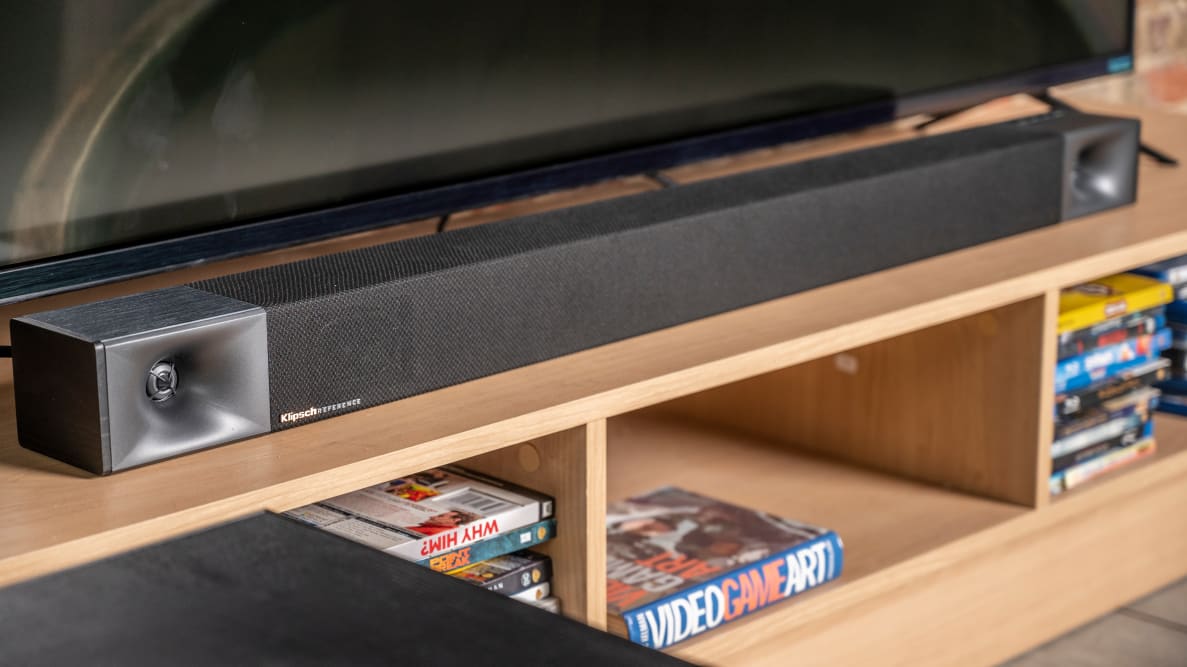Pros
-
Refined sound signature
-
Impressive bass response
-
Stylish design
Cons
-
No Wi-Fi
-
Stereo sound only
-
Short on features
The two bars in Klipsch’s Cinema Series, the Cinema 400 and the Cinema 600, follow the same general blueprint. Based on the way Klipsch markets these bars, as well as their actual performance, it’s clear the Cinema 400 and Cinema 600 were meant to be simplistic, superb-sounding additions to living rooms and home theaters alike. The Cinema 600 has the added benefit of a dedicated center channel and a larger subwoofer—for a $200 upcharge—but the concept remains the same.
What the Cinema Series does not do, however, is incorporate features and perks that have infiltrated this price range in recent years. The Cinema 400 does not decode a wide range of sound formats, nor does it offer the kind of customizable audio settings that alternatives like the Polk Signa S3 or the Vizio V Series 5.1 soundbar both possess. The Cinema 400 is also missing WiFi, a feature that bars like the Yamaha YAS-209 and Sonos Beam add for not much more. Buying this bar from Klipsch is an investment in sound and sound alone. For that purpose, it’s money well spent.
About the Klipsch Cinema 400
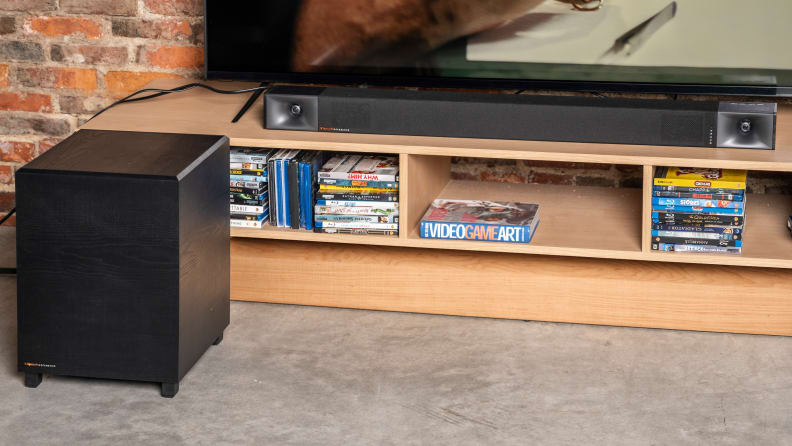
Klipsch's Cinema 400 soundbar, pictured with its included wireless subwoofer.
Here’s a glance at the Klipsch Cinema 400’s specifications:
- Height x Width x Depth: 2.9 x 39.9 x 3.4 inches (bar), 11.9 x 16.1 x 16.1 inches (sub)
- Weight: 27.5 pounds (total)
- Speakers/drivers: two 3-inch oval fiber composite cone midrange woofers, two 1-inch soft dome tweeters mated to Tractrix horn (bar), one 8-inch ported subwoofer (sub)
- Amplification: 400 watts of claimed power
- Wireless Connection: Bluetooth
- Wired connection: HDMI ARC input/output, 3.5mm analog input, optical input, subwoofer output
- Sound formats: Dolby Digital
In addition to the soundbar itself, which sits at nearly 40 inches long, the Klipsch 400's L-shaped box includes a wireless subwoofer, power cords for both pieces of the ensemble, some wall mounting hardware, an HDMI cable for seamless connection to your TV's HDMI ARC port, and a remote complete with AAA batteries. It’s a thorough list of accessories, but it’s standard for the most part.
One intriguing note here: Klipsch's marketing team says the Cinema Series Soundbars have the largest wireless subwoofers on the market, and they aren't kidding. The included 8-inch wireless subwoofer in the Cinema 400 package may be dwarfed by the woofer of its larger counterpart, the Cinema 600 but it’s still one of the larger soundbar subwoofers I've dealt with to date. As for style, it actually looks like a traditional home theater subwoofer, as opposed to other soundbar subs that more closely resemble computer towers than products capable of providing impactful low end.
What we like
A refreshingly distinctive aesthetic
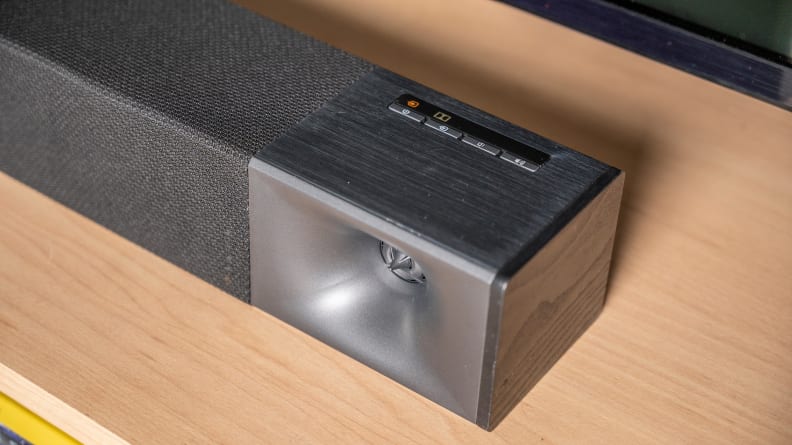
A close-up of the horn tweeter on Klipsch's Cinema 400 soundbar.
Many reviewers (myself included) will say that as a general rule of thumb, a well-designed soundbar is a bar that doesn’t draw attention to itself or stick out from its environment. To a fault, the majority of mainstream soundbars achieve this aesthetic in one way or another; the typical bar is black, sleek, and without many substantial design aspects to differentiate them from their counterparts.
Every so often, a soundbar will break that mold, and it’s noteworthy when then they do. In the case of the Cinema 400, on each end of the bar sits a Tractrix horn with linear travel suspension tweeters at the center. It’s not only a convincing nod to the signature horn design of Klipsch’s long-running line of home theater speakers, but a kind of immediate declaration that this bar is ready to sacrifice conventional norms in the name of sound quality.
The wireless subwoofer follows the same approach, crafted from real wood materials in such a manner that the compact little woofer shares a striking resemblance to Klipsch’s heftier home theater subs. The Cinema 400 does have a subwoofer out port, so in theory, you could add one of those full-sized thumpers. But the bar’s stock woofer does such an impressive job both in style and sound, that won’t be necessary for most folks.
Audio with attention to detail
The traditional knock on Klipsch speakers derives from those pronounced horns. A quick Google search reveals that many in the home theater community have characterized these horn tweeters as sounding a touch too bright, resulting in harsh higher frequencies at times. While I can’t speak for everything in Klipsch’s line, I can attest that the Cinema 400 doesn’t suffer from that issue.
Sound is subjective to a point, of course, so your ears may very well differ. But from an extensive period of throwing everything but the kitchen sink at the Cinema 400, this bar presents a well-rounded sound signature that accurately hits those higher frequencies without venturing into dangerous territories. It excels with most genres of music, ranging from tracks from Chris Stapleton’s new album Starting Over to selections from artists like Childish Gambino or throwbacks from Fleetwood Mac. The Cinema 400 is as musical as they come for the money, and it’s a huge selling point for this bar.

When it comes to movies and TV, I was honestly surprised at how cinematic and detail-oriented the experience is for a two-channel bar. Toward the end of a late-evening viewing of You Were Never Really Here, the soundbar delivered such a visceral interpretation of a gunshot that it brought various animals and individuals on our couch to a startled awakening.
While it doesn’t physically have the drivers usually needed for that encompassing theater experience, chances are you’ll be more than pleased with the sound supplied by the Cinema 400 for movie nights.
Captivating low end
The crowning achievement of the Cinema 400 is that wireless subwoofer. With several soundbars on the market, the low end is “there” in the sense that it fills out the necessary lower frequencies for music listening. But it often becomes apparent that these space-deprived woofers are not able to create the reverberating depth that so many powerful scenes in cinema demand.
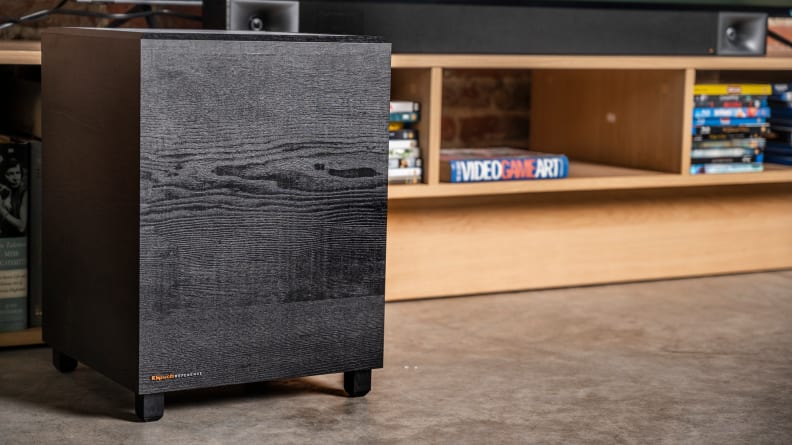
The wireless subwoofer included with the Klipsch Cinema 400 soundbar.
The Cinema 400, by comparison, is a different beast. Tony Stark playing keep away from F-22 Raptors in the original Iron Man? Room-shaking. That classic T-Rex introduction in Jurassic Park? Breathtaking. Heck, even John Oliver literally obliterating the year 2020 in the season finale of Last Week Tonight was a resonating spectacle to behold.
It's clear Klipsch put great effort into designing a soundbar subwoofer that actually sounds the way a woofer should. Thunderous bass isn’t quite for everyone, of course, and the included remote does let you adjust the sub’s response to your personal liking. But for those accustomed to subwoofers capable of threatening every wall fixture in the house, the Cinema 400 does a remarkable impression of its larger relatives.
What we don’t like
Stereo can only do so much
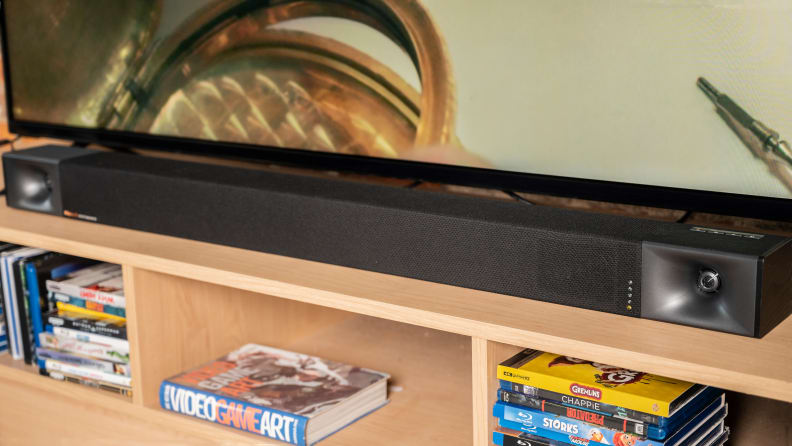
As much as the capabilities of the Cinema 400’s two-channel setup should be applauded, there is a point when the ultimately standard sound comes back to earth. There’s no dedicated center channel to speak of here, and while the stereo bar wasn’t always exposed, the struggles faced by the left and right channels to create clear dialogue and compelling action simultaneously became apparent when watching high-octane flicks like Marvel films or editions of John Wick. The bar does have a Dialog Enhance Mode, but it doesn’t completely remedy the issue.
The same goes for the Cinema 400’s Virtual Surround Mode. It certainly has moments where it seems to create a more expansive soundstage. But more often than not the two-channel system faced an uphill battle trying to replicate surround sound, resulting in audio that sounds unnatural. I left it off for most of my evaluation, simply because the mode hurt the experience more than it aided it.
Moving up to the Cinema 600 solves most of these problems, for a few reasons. The Cinema 600 does have its own center channel, lightening the workload of the left and right speakers and giving dialogue a dedicated speaker. It’s also compatible with Klipsch’s Surround 3 wireless speakers, which creates a physical surround sound experience that undoubtedly surpasses the quality of a virtual effort. Of course, the Cinema 600 itself does cost $200 extra, with an additional $250 for the Surround 3. That amounts to a steep price hike compared to the Cinema 400, but it might be worth it for those hoping for a more theater-worthy setup.
Not many extras
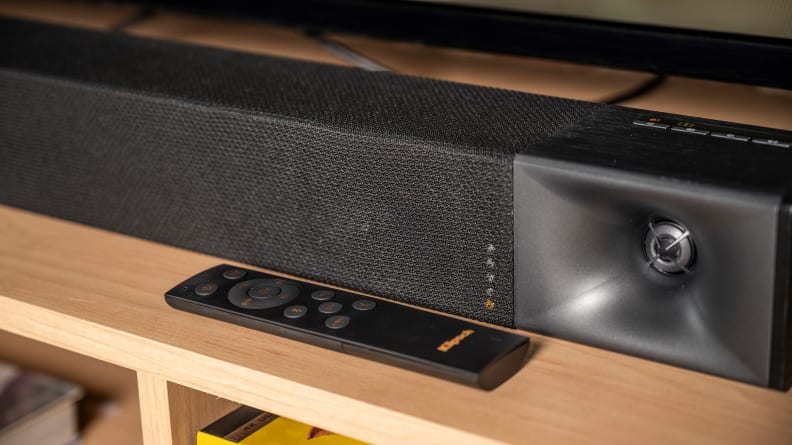
It’s been expressed at least a few times by this point, but the Cinema 400 does not have a plethora of features to its name. Compared to other bars surrounding the Cinema 400, inputs are somewhat limited (most bars at this price offer a spare HDMI input), supported sound formats are almost nonexistent, and wireless connection options are disappointing. In a few words, this is not the bar for frills fanatics.
That goes for those who want to meticulously tinker with their sound settings. The Cinema 400 has the aforementioned Dialogue Enhance Mode and Virtual Surround Mode, as well as a night mode that dampens dynamic sounds and an independent level control for the wireless subwoofer. Missing, however, are specific modes for movies, sports, and music like the Yamaha YAS 209, or more comprehensive equalizers found in Vizio’s V-series bars.
Frankly, the Cinema 400 is so well-tuned already that most customers wouldn’t want to mess with the sound settings anyway. But it would be helpful to adjust the sound to your specific tastes if you wanted to.
Without WiFi in a wireless world
From a broader standpoint, a $300 (or $500 for the Cinema 600) soundbar without WiFi in the year 2020 should not be a thing. Technology has come too far, and too many similarly-priced bars have successfully implemented WiFi for this not to be adopted as the standard. As a caveat, it’s understandable why the Cinema 400 does not have WiFi. Concessions have to be made to develop a soundbar that sounds this good as affordable as it is, and that concession in this case is WiFi connectivity.
Without WiFi, you don’t have many options for streaming music, installing firmware updates, let alone interacting with your favorite smart assistant. To be fair, you can buy a cheap Amazon Echo device, pair it with the Cinema 400, and enjoy some of the perks of a WiFi-enabled bar. But having an internet connection from the get-go requires less parts and truly simplifies streaming music to a bar that’s demonstrated itself to be a musical asset.
Should you buy it
Yes, unless you value features over sound
The Cinema 400 sounds great overall when it comes to both music listening and movie watching, it's easy to setup, and it doesn't cost a fortune. For most soundbar buyers, those are the qualities that matter most.
If you're the type of person who would prefer to fine-tune your audio settings, stream effortlessly over WiFi, or tap into the immersion that additional speakers are sure to provide, there are other bars that might be of interest. Yamaha’s YAS-209 is our top-ranked soundbar for its combination of features and value at $350, and the $399 Sonos Beam isn’t far behind. It’s even possible to get full surround sound for less, with the Vizio V Series 5.1 soundbar coming in at a cool $250.
Still, it is really hard to beat the sound quality that comes with the Klipsch Cinema 400 for the price. If affordable audio is a top priority, the Cinema 400 should be on a short shopping list of potential new bars for your living room.
Meet the tester
Nick Woodard is a tech journalist specializing in all things related to home theater and A/V. His background includes a solid foundation as a sports writer for multiple daily newspapers, and he enjoys hiking and mountain biking in his spare time.
Checking our work.
Our team is here to help you buy the best stuff and love what you own. Our writers, editors, and experts obsess over the products we cover to make sure you're confident and satisfied. Have a different opinion about something we recommend? Email us and we'll compare notes.
Shoot us an email
